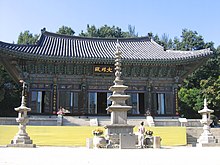Bongeunsa
| Korean spelling | |
|---|---|
| Korean alphabet : | 봉은사 |
| Hanja : | 奉 恩 寺 |
| Revised Romanization : | Bongeunsa |
| McCune-Reischauer : | Bongŭnsa |
Bongeunsa is a major Buddhist temple in Seoul , South Korea . It is located north of the COEX Center in Gangnam-gu District, Samseong-dong District.
history
It was founded in the year 794 by Yeon-hoe, the highest ranking monk of the Silla period, south of the Han River.
His name was initially Gyeonseongsa ( seeing real nature). During the subsequent Goryeo period, the temple fell apart. It was rebuilt in 1498 by Queen Jeonghyeon and renamed Bongeunsa (offer support).
It was originally located southwest of King Seongjong's tomb . As part of an expansion of the royal mausoleum, it was rebuilt east of the tomb.
During the Joseon Dynasty (14th to 19th centuries), Neo-Confucianism was the state religion, while Buddhism was suppressed by the state. Monks were on the same social level as slaves, they were not even allowed to pass through the city gates. Only during the reign of King Myeongjong (1545–1567) did the status of Buddhism change. The king was too young to be in government, so his mother, Queen Munjeong , exercised strong political influence. She was well disposed to Buddhism and in 1548 placed the administration of the temple in the hands of the monk Bo-wu. In 1551 Bongeunsa became the main temple of the Jogye Seon order. From here the renewal of Korean Buddhism started. However, Bo-wu was murdered by anti-Buddhist extremists shortly after Queen Munjeong's death.
In 1562, during the reign of King Myeongjong, the temple was relocated about one kilometer to the northeast, to the current location north of the World Trade Center .
The temple burned down in 1592 and 1637 and was then rebuilt. Extensive renovations took place in 1692, 1912, 1941 and 1981. During the Korean War (1950–1953), most of the buildings in the temple were badly damaged. Therefore, today's buildings are mostly from more recent times.
meaning
In 1902, a new law made Bongeunsa one of the 14 main temples in Korea, and in 1911 it became the central temple for around 80 smaller temples in Seoul and the surrounding area.
During the severe floods in 1922 and 1929, the monk Cheong-ho saved over 700 people from drowning, which significantly increased the public image of the temple.
After independence from Japan in 1945 Bongeunsa was directly subordinate to the Jogye Order, the largest Buddhist religious group in the country. It is a religious center of Zen Buddhism in Korea.
With its history and unusual location in the middle of the ultra-modern and bustling Samseong-dong district, the temple is a sacred oasis of calm and a place of pilgrimage for 200,000 lay Buddhists.
The most important cultural treasure is 3479 wooden block inscriptions with 13 different sutras (sacred texts), which are exhibited in the Panjeon (next to the main temple).
At the back of the temple area is Mireukdaebul, the largest Buddha statue in Korea at 23 meters . It was built over a period of ten years, between 1986 and 1996.
Since 1972, Bongeunsa has housed an institute that translates sutras from Chinese into Korean.
Web links
Coordinates: 37 ° 30 ′ 56 ″ N , 127 ° 3 ′ 26 ″ E

